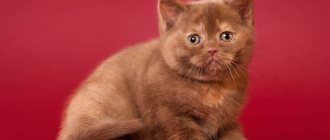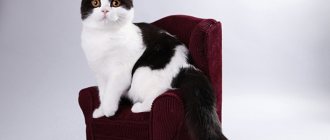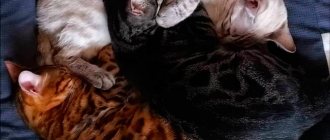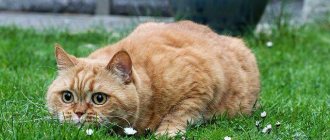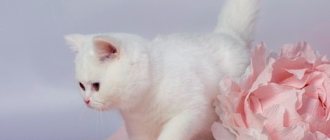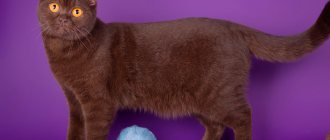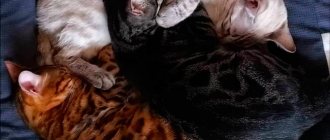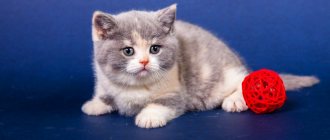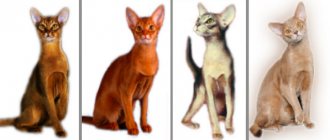02/22/2020 6,936 Interesting things about cats
Author: Olga
If you have decided to have a gentle, clean pet, then the British Chocolate cat requires special attention. The unique feature of these pets is their devotion to the owner. The cat can find something to do while you are not at home. However, this does not mean that he will not start to get bored. The kitten will be able to entertain not only itself, but also you. The chocolate color will not leave anyone indifferent. The photo serves as excellent proof of this.
[Hide]
British standard
At the present stage, approximately 60 different fur colors have been recorded. A kitten can be blue, black, cream, lilac, red, tortoiseshell, etc. Among the newest and rarest, a cat with chocolate-colored fur occupies a special place. You should know that if stripes or marks of a different color are present, the four-legged furry is discarded.
British chocolate cats are rare. This can be attributed to the fact that a similar color is found only in those animals that have Color Point ancestors with the same coat color in their family. Chocolate British cats have a calm, friendly character. Their short fur is not capable of causing much trouble when cleaning rooms.
BRITISH CHOCOLATE KITTENS: PHOTOS OF SMALL KITTENS
The gallery contains photos of British chocolate-colored kittens.
| In our cattery you can “buy a real British kitten.” We have many different colors, we will help you choose and answer all your questions! |
Genetics of colors
The genetics of the formation of cream color in British cats is closely related to another primary color – red.
- The O gene is responsible for the red color. It has one feature that is unusual for other colors - the gene attaches to the X chromosome, which affects the sex of the future kitten.
- In British female kittens, the defining characteristic is the XX chromosomes, and in boys, the XY chromosomes. It turns out that two O genes can join the chromosomes in a cat, but only one can attach to a cat.
- Each gene is found in a dominant (O) or recessive (o) form.
- In the first case, the combination of OO dictates the obligatory output of red-colored offspring, the OO variant gives the hereditary instruction of a non-red (black) color, and OO extends to tortoiseshell color (in female kittens).
- For boys, the situation is different - one X chromosome and only two options: red and black.
- Cats inherit the color gene from their mother's side. In the case of OO, everything is clear - the animal will definitely be red. The second scenario (oo) is also simple - the British will be black. But in the case of Oo, the baby will take on the dominant red color from the mother cat. Therefore, more red male cats are born than girls.
The second gene, which forms the cream color, is designated D (dilutor, dilutor). In the cat's genetic map, it affects lightening and comes in two forms: dominant D (no lightening) and recessive dd.
At the final point, black turns into brown, chocolate into lilac, cinnamon into fawn, and red into cream. Inheritance of color occurs only from parents to offspring.
It is important! Cream British kittens are only born when both parents have the D gene.
History of the breeding of British chocolate
Breeders were not involved in the targeted breeding of brown fur in British cats . This color is not so common; it is characteristic of eastern representatives of the cat family (Burmese, Oriental, Siamese, etc.). The goal of the breeding work was to obtain color-point color in plush cats, for which they were crossed with color-point Persians.
The purpose of breeding the breeders was the color point color, and the chocolate color turned out to be an accident
The first chocolate Briton was born by chance in the 80s of the last century. But the color was so deep and luxurious that later breeders began to strive for a pure dark brown shade. British cats of this color are very popular.
Fur of four-legged friends
The main color of animals is chocolate color. It has a deep and rich shade. According to the standard, there should be no tabby marks, spots or light-colored hairs at all. The chocolate pigment should be distributed evenly throughout the coat. In this case, the hairs should be soft and short.
Kittens take a long time to acquire a truly chocolate shade. In some cases, the formation process can continue for 15 months. Sometimes the fur can acquire a brown tint, as shown in the photo. However, over time, kittens lose it.
British cats can have fur of different shades of chocolate. Therefore, it will be possible to find pets whose fur coat may be the color of a bitter or milky dessert. A kitten of this color is very popular today. In this, it is not inferior to its purple and blue counterparts.
How to determine the color of a British cat
The color of a British cat is determined visually, and the final decision is made only upon reaching the age of 1–1.5 years - until this time, the coat may fade and change. An expert can give the most accurate assessment. A specialist must study the main color, the presence of rejection characteristics, pattern and shading (if any) - all this can really be done by eye, knowing the requirements for the numerous colors of British cats.
There is such a procedure as conducting a genetic test (using any biological material, most often blood). It also relates to the determination of color, but not of an adult animal, but of its future offspring. Based on the results of the analysis, it is possible to determine the carriage of certain genes, which will allow you to select a partner to obtain the desired color. So, for example, any British dog can get a lilac coat color, but only if both have a recessive form of the d gene. Such a test is of great importance for breeding work.
British cats are not only the familiar gray plush pets, this breed boasts a huge list of possible colors. Various monochromatic (solid) variants can be called classic, and active breeding work has made it possible to create the most incredible combinations, in particular, tortoiseshell multi-color colors with a tabby pattern.
Appearance Options
The Chocolate Briton has a strong build and a wide chest. Cats usually have short legs and a round head. It should be noted that the cat has fairly wide cheekbones. A kitten or cat's ears are straight. They are located quite widely.
The cat has eyes that are dark orange or copper in color. In this case, the more saturated the shade, the better. Purebred kittens have dark brown fur.
For a long period of time, chocolate-colored cats could only be found among representatives of oriental breeds. We are talking about Siamese, Oriental, Burmese cats. The British cat got its chocolate shade thanks to Persian Colorpoints of the corresponding color.
An interesting thing is that chocolate kittens have become more popular over time compared to their counterparts, thanks to which they acquire a beautiful shade.
Popular breeds
Let's consider relatively inexpensive cat breeds, which also happen to be “chocolate” in color.
Abyssinian cats are fit, short-haired animals with a medium build. The color of Abyssinians is dark brown, approaching black. A stripe with a red-brown tint runs through the ridge line. The overall color ranges from coppery tan to reddish brown. Ticking can be double, even triple, which means that each hair of the coat has two or three shades. As for the brown range of Abyssinians, it includes wild, bay and beige colors.
Havanese cats are named after the corresponding shade of Havanese cigars. And all because the color of the very first representatives of the breed was tobacco, dark brown. Havanese cats are short-haired and uniform in color. The breed was originally called the "bay brown" because there were doubts about its true British origin, but these have now disappeared. The breed is again called Havanese, which suits it much more.
Chocolate Persian cats have an excellent build and a wide chest. Their bodies are stocky and strong. The head is proportional to the body. The nose is slightly flattened, like Persian cats of all colors, and the coat is long and soft. The brown color range includes all shades, but other tones are excluded in this situation. The undercoat can be colored gray or have iridescent tints. The beauty of a cat is enhanced by its eyes, which can be orange (amber) or emerald green.
Chocolate exotics (professionally called “Seal Point”) are a breed of American origin. The chocolate color can be either uniform or marbled. Shades of brown range from coffee to tree bark tones. Exotics are short-haired, attractive due to their interesting, original muzzle and round large eyes. Their charm is enhanced by their bushy tail. They have an average build.
Burmese cats are strong and muscular. The breed originated in Burma, created in 1934. For short, they are called “Burmese”. They have yellow eyes and brown fur, that is, dark brown.
Devon Rexes are alien cats. Large-eared, narrow-muzzled, with almond-shaped eyes. Devon Rexes have a slender body build. The appearance of these cats is as unusual as possible. In addition to the original body proportions, they also have curly hair. Breeding the breed is not easy, since in this situation the principle of backcrossing applies, otherwise the curly trait will disappear.
British cats of chocolate color with blue eyes are incredibly beautiful. They are plush in appearance and touch, and thanks to the color of their fur, they look like little bear cubs. The British are shorthaired, but their coat is unusually thick. Chocolate British cats have a medium build. The “chocolate” color on the British is very deep, rich, and evenly distributed. Sometimes it may have a brown tint. Uniformity of color is achieved over a long period of time – from a year to a year and a half. The chocolate British cat looks very “pedigreed”.
Scottish Fold cats can be all shades of brown. Does not have to be uniform, it can be brindle, merle, ticked or spotted, and tabby is also acceptable. Scottish cats are allowed to have white spots. Such cats are called harlequins or bicolors. Harlequins are predominantly white in color, but have large chocolate-colored spots on the body and legs. In bicolors, on the contrary, brown predominates; small spots of white are present on the paws or chest.
The breed is distinguished by the unusual shape of its ears - they hang above the head, directly adjacent to it. The character of the Scots is meek and kind. The fur is mostly short, but on the tail it is quite bushy.
Tabby
The Tabby (Tabby) color allows cats to have patterns of different directions, sometimes the coat can even be ticked or marbled. The main signs of a Tabby are the letter M located on the animal’s forehead (scarab sign), dark stripes near the eyes and on the cheeks, and rings on the neck and chest.
The brindle (mackerel, striped) color option is considered the most common among tabbies. A line of the main coat color runs along the entire spine. From the name it is clear that the pattern is made up of dark stripes. A clear and separated pattern is a requirement made by specialists. If this rule is violated, the animal is rejected. The eyes are bright - red and copper.
The British spotted tabby cat is distinguished from others by horizontal dark lines extending from the eyes. There are also stripes on the animal’s cheeks. A dark broken line runs along the spine, and on the sides there are a large number of dark spots and dots. The tip of the tail is dark, with striped rings running along its entire length.
Spotted tabby color
The British merle tabby color is considered classic. It is characterized by light silvery sides with dark spots or stripes. The pattern looks very impressive, since it is not interrupted or intersected anywhere. On the back of the head there is a pattern in the shape of a butterfly, and the letter M, standard for the color, is located lower than usual, closer to the nose. Eye color is copper with smoky rims. The British Marbled cat looks expensive and elegant.
We suggest you familiarize yourself with: List of horse names, how to name a stallion
Interesting! Small kittens may have an undivided merle color. When they reach the age of 2 months, the pattern becomes clear.
Torby (tobry) is a color that combines two color varieties: patterned and tortoiseshell tabby. A spotted, marbled or striped pattern arrangement is allowed. The standard assumes that the British tortoiseshell tabby color has rings on the neck, stripes on the legs, the letter M on the forehead, which is characteristic of all tabbies, and rings along the entire length of the tail. In kittens, identifying this type of pattern is problematic, but as they grow older, at about 12 months, the lines become clearer.
For many, this coloring of a cat looks like it is uniform, but it is not. The color is original, since the top part of the coat looks like a light dusting, and this shade is identical to the color of the lower part of the undercoat. Most often these colors are blue, black and chocolate, but others are also allowed.
Peculiarities of chocolate British participation in cat shows
If a British chocolate cat exactly meets all breed standards, is healthy and has no external physical defects, and also has the necessary documents (pedigree), then it can take part in any cat shows.
Preparations for exhibition events are carried out in advance:
- The animal is bathed (if the coat looks oily) with a special shampoo. It is recommended to use conditioner (same brand).
- Clean ears and eyes.
- Carefully trim the claws.
- Using a special brush and toothpaste, brush your pet’s teeth (2-3 days before the event).
To prevent the rich brown color from fading or fading, the animal should not be exposed to direct sunlight. Tinting and tinting wool is strictly prohibited.
The show animal must meet all breed standards
Individuals with the following deficiencies are subject to disqualification:
- white inclusions, stripes, spots or lighter undercoat (brownish or gray);
- eyes of an inappropriate shade or rim around the iris;
- not brown color of the nose and paw pads;
- excess or insufficient number of fingers;
- undershot or overshot (more than 2 mm);
- tail defects (bends, creases);
- the coat is too long or very fluffy.
Our neighbor has a black cat who leads a free lifestyle. He spends most of the warm season outside, free-ranging. He comes home only to eat. Since in the summer he is often exposed to the sun, his fur fades greatly and becomes an unsightly brownish-brown color. In winter, when it is frosty outside, he sits at home and after molting again becomes blue-black.
British character
The British cat and cat are distinguished by their affectionate nature. They become quite attached to their owner. However, they are able to easily endure separations. The main thing is that they are not too long. By temperament, chocolate-colored pets are calm and balanced.
They can only show character when eating. In this regard, they are quite demanding. The cat is able to insist that food be served on time. Therefore, it is important to immediately determine the feeding regimen and follow it.
The video clearly shows what they are like - British chocolate cats.
Who are the British
All representatives of the British breed, regardless of color, are distinguished by a rather massive and muscular physique. The body is compact, round and very harmoniously designed, with a wide, large chest and slightly short, strong legs. The average weight of males is 6–8 kg, but sometimes reaches 10 kg. Females are much smaller and lighter.
British cats have a massive build
The British have a large round head on a massive neck, with thick convex cheeks and a firm, pronounced chin. The ears are straight, medium-sized, and set wide apart. The eyes are large, round and well open. The tail is not distinguished by its outstanding size; at the base it is thickened to a rounded tip and slightly narrows. The coat is extremely thick and short with good quality undercoat and is very soft and pleasant to the touch.
Where to buy kittens?
We all have a natural desire to save money, and unscrupulous people often take advantage of this. Buying a purebred animal is no exception to the rule; today such deceptions are not uncommon.
A purebred kitten cannot be cheap; if you are offered a show-class kitten, then you should immediately suspect something is wrong. Either they openly want to deceive you, or you are faced with an inexperienced cat lover who doesn’t even know all the ins and outs about the breed. In this case, immediately refuse the purchase.
Do not take kittens only based on an advertisement on the Internet; they can sell you a British kitten without documents. How much such a kitten costs is not even worth finding out, because no one can guarantee that both parents are purebred and have no defects in their pedigree.
The best purchasing option would be to contact a specialized nursery, where they will not only sell you a purebred animal, but will also give you detailed advice on raising and feeding a kitten.
Upbringing
If you are attracted to kittens of a given breed and color, and after looking at numerous photos and videos, you decide to get a pet, you should understand that you will practically become a parent for it. Chocolate fluffies are no different from other little four-legged friends. They love to be active, playful, and want to receive affection and praise from their owners.
Kittens are very curious creatures. In their quest to know everything, they are capable of crawling around the entire house. A kitten can charm quite easily, as evidenced by various photos. Spontaneity and sweet habits and habits help him in this. However, from a young age he must be taught discipline. This will help get rid of numerous problems and protect your pet from all kinds of injuries.
Kittens must understand immediately what can and cannot be done. Hitting and swinging at the fluffy is not recommended. You should stop pranks with your voice. This will help not embitter the baby. If you approach your upbringing wisely, kittens will not put out their claws, bite, crawl on clothes or damage furniture. Don’t forget that both cats and cats of popular colors need affection and praise.
What to look for when choosing a kitten
If you have the time, energy, opportunity, and patience to deal with such a pet, feel free to get such a pet. When you see a chocolate kitten, it seems so cute that you want to pick it up and stroke it, cuddle it... But you and I already know that cats of this breed do not like and will not appreciate such manifestations of your feelings. So - if you need an affectionate kitten who sits patiently in your arms - give up this proud one. Otherwise, these kittens are very friendly, calm and balanced. They are not very picky and picky when it comes to food - they will eat what you are accustomed to.
As for discipline: the kitten must immediately be made to understand what is good and what is bad. You can prevent his pranks, but not with beating, but with a stern voice. If you raise a kitten correctly, you will not have problems with damaged furniture and other troubles in the future.
In Europe, it is believed that the best age to purchase a kitten is 3-4 months. At this age he is already independent, and the first vaccinations have already been done.
He will get used to new living conditions faster than a small kitten
The most important thing is to determine whether the kitten is healthy. You can judge this by appearance: a healthy pet is well-fed, but not pot-bellied; if the ribs stick out, this is a clear sign of exhaustion
Examine the fur carefully: healthy cats have even, smooth, shiny hair. There should be no damage or bald spots on the skin.
A healthy cat's eyes are clear, and nasal discharge indicates respiratory disease. You should see pink gums and even baby teeth when you look into the kitten's mouth. Be sure to look at his gait: he should be active, mobile and curious. Usually, kittens of this breed are easy to train, but at first you need to be patient and affectionate. After all, it has long been known: the more love and affection we give, the more the animal will give us back in return! Good luck.
On video: how to wash a British cat.
How many breeds are there?
There are not as many cat breeds as there are dog breeds, but there are still plenty to choose from. Even an avid cat lover cannot give the exact figure, because there are many associations and clubs in the world involved in the classification and exhibition of cat breeds. And their accepted breed standards may differ from each other, and if in one association a breed is considered recognized, then in another it will be only a branch of another.
On average, today there are over a hundred cat breeds, and together with the varieties there will be all seven hundred. Among them there are both large and small breeds, as well as with different colors and coats.
The British breed is recognized as one of the most popular in the world, and how much a kitten of the British species costs depends on a number of factors, which we will discuss below.
Breed characteristics
Standard
Ideal exotics are well-balanced, with heavy and powerful bones and rounded body lines. The dense, plush coat emphasizes the overall roundness of the cat's shape and softens the lines of the cat's body. Large round eyes complete the look.
The breed standard standards are as follows:
- Body: stocky, large or medium in size, with short legs, deep and wide in the chest, massive across the shoulders and rump. Muscle tone is good without signs of obesity. The middle part is rounded, the back is flat. Weight 3-6 kg.
- Coat: Plush, dense, standing away from the body due to the thick undercoat. The texture is soft. The length is average and depends on the undercoat.
- Color: all colors are accepted except fawn and cynamon. For tabbies, the points are divided into 10 for stripes and for color, for bicolors - 10 for white distribution and for color. Red bicolors are popular, as are tortoiseshell cats. Solid colors, such as pure black and white, are less common.
- Head: round, massive, well set on a thick short neck. The skull is wide with a convex forehead, full cheeks. The jaw is wide and powerful. The chin is strong, emphasizing the correct bite.
- Eyes: large, round, bright. Set far apart from each other, low on the head. Eye color corresponding to color.
- Ears: small, rounded, set wide and low on the skull, tilted forward.
- Limbs: legs short, thick, strong. The paws are round, large, with tufts of hair between closely spaced toes. There are five toes on the front legs and four on the hind legs. The tail is bushy, short, with a rounded tip, at a slight downward angle relative to the back of the body, without bending.
Health
The average lifespan of a cat is 12-15 years.
The following diseases are inherent in the breed:
- Breathing and sinus problems due to a thin nasal septum.
- Narrowing or complete obstruction of the nasolacrimal duct and, as a result, lacrimation .
- Dental problems – gingivitis, abnormal development of the lower jaw, periodontal disease.
- Obesity.
- Genetic predisposition to kidney disease, cardiomyopathy .
Character of an exotic shorthair cat
Exotics have a very friendly and peaceful character. Representatives of the breed are able to get along with all family members and other pets. However, to form connections in a new family, they need time - at first the animal observes everything that is happening, and then chooses the main person for itself - the owner, and demonstrates almost canine devotion to him.
Unlike their close relatives, the Persians, exotics are playful and curious, but at the same time very unobtrusive.
They can wait for hours for permission to climb onto their owner's lap or for a desire to play with them. They prefer quiet games, without actively running after a toy. In childhood they are more active, and as they grow older they become more balanced.
Belongs to silent breeds, will not bother household members with demands for food or attention. Prefers to attract attention to himself with long, inquisitive glances. Sometimes they may show persistence in the form of stroking with a paw or rubbing against surrounding objects.
Exotics are intolerant of loneliness; they always need company and the presence of their beloved owner nearby. They can easily endure trips and transfers. They are tactful and tolerant towards children, but can show displeasure when their comfort is disturbed too much. Hunting instincts are rarely shown.
The breed responds well to training and training. When raising, the main rule is the absence of aggression and harsh measures - the psyche of animals is very susceptible to physical punishment or raising their voices. Exotics easily remember the location of the scratching post and toilet, can learn simple commands and know prohibition words well.
Exotics are clean and often lick themselves , so it is recommended to buy malt paste for them to remove hairballs from the stomach.
Where is the price higher?
If you ask how much a British kitten costs in Moscow or another metropolis, and compare the prices with the cost of kittens in the regions, you will be unpleasantly surprised. Pedigree animals in the capital will cost more than kittens from the regions.
The reason for this is clear - everything is more expensive in Moscow. But another question arises: is it worth buying kittens from the regions or paying more, but buying in the capital? And here not everything is clear.
In big cities, prices may be higher, but there is also more choice. In addition, you can find breeders who have been breeding this breed for more than one year and regularly participate in exhibitions. This means that you will be able to purchase not just a kitten from breeding parents, but also, possibly, champions of your breed. But you need to be prepared for the high cost of the animal.
In small regions there is another extreme - there are practically no professional breeders, and there is no need to talk about participation in exhibitions.
Origin story
The breed appeared in Great Britain in the 19th century. About 10 years were spent on selection. The color was obtained by crossing recessive forms of British cats of chocolate and blue shades. According to statistics, only a quarter of pets are born with a similar shade. About 30 years ago, felinologists officially accepted the color.
The belief that the color was created by crossing a Scottish fold cat and a marbled cat is incorrect. The result of this will be the birth of kittens with disorders at the genetic level.
The British Lilac cat is not a separate breed, but belongs to British cats with short hair; the main difference with other representatives lies in the shade of the coat.
There is no breed of British Fold. There are only short/long-haired British and lop-eared/straight-haired Scots.
colors of British cats photo and name
The popularity of the British cat, according to popular belief, is a large, well-fed animal with a sweet face and amazing fur of gray, smoky, blue tones. This is not entirely true; more than 60 colors have been developed, of which, due to their originality and rare combination of wool colors, fans identify 10 that are especially in demand.
Marble
The marbled British tabby cat resembles the fur coats of animals from Asia and Africa. The marbled Briton looks luxurious; many breeders and felinologists took part in improving the tones. The main characteristics of the coat of a British marbled cat are presented in the table.
marble Briton photo:
Table No. 1. Characteristics of a marbled cat
Whiskey
The British Whiskey cat belongs to the tabby variety, has a white-silver marbled color with a pronounced dark gray or black pattern.
This species got its name thanks to the cute British cat featured in the popular Whiskas advertisement. The little Briton has become popular with many TV viewers because of his beautiful, memorable coloring.
British whiskey photo:
Table No. 2. Characteristics of the Whiskas marble cat
Brown
The color of the British brown color point cat is also called “Himalayan”. The entire body has a light warm tone, the markings are dark brown. The dark brown tone of individual parts of the body, muzzle, ears, tail and paws is a distinctive feature of color point colors in combination with the light color of the animal’s body.
brown brit photo:
Table No. 3. Characteristics of a color-point brown cat.
Chocolate
British chocolate cats have a rich, deep color. They are also called Havana, chestnut, for the dark chocolate tone of their coat. With such a color from milky to dark, the chocolate Briton is very much appreciated at exhibitions; breeders and cat lovers are happy to purchase it. The chocolate-colored Briton has one peculiarity: its true tone is determined at the age of one and a half years. It's hard to tell from a chocolate newborn British cat what color it will be as it ages.
chocolate Briton photo:
Table No. 4. Characteristics of a chocolate cat.
Cinnamon
British with cinnamon or cinnamon color, one of the rare animals with this color. The new species was officially recognized under the WCF system only in 2006. The unusual appearance of cats' fur with copper tints and a lighter tone than chocolate made cinnamon very popular among the British, but it is extremely difficult to find it at exhibitions or to come across it.
Table No. 5. Characteristics of the cinnamon cat
Description Color characteristics Features.
Peach
Cream British with a delicate peach color is also called beige because of its very light, uniform coat, where all parts are dyed and have an even tone from base to tip. Cream British breeds look like a peach with their elegant coloring.
peach british cat photo:
Table No. 6. Characteristics of the peach cat.
Tortoiseshell
British tortoiseshell cat, this unique color is called tortoiseshell. The most diverse range of wool colors. The palette consists of two groups: red and black, and has up to eighty different options. British tortoiseshell color, acceptable only for cats. A British tortoiseshell with such hair at birth has a genetic anomaly - mosaicism. British tortoiseshell cats are always infertile.
British tortoiseshell cat photo:
Table No. 7. Characteristics of a tortoiseshell cat.
brindle
British brindle cats have fur patterns characteristic of wild animals. These British people are like little tiger cubs. Patterned tabbies have a distinctive "M" type mark on their forehead and a coat with stripes, spots, rings on the body, paws and tail. Narrow stripes on the body after 2 years may lose continuity and change color to leopard.
british brindle photo:
Table No. 8. Characteristics of a tiger cat.
Gold
The golden color is practically never found in its pure form among the British. They are called golden chinchillas, their fur is 1:8 powdered with a golden coating. Cats with this color are the most expensive in this breed. The face has dark eyeliner and nose, and the paw pads are black.
golden brit photo:
Table No. 9. Characteristics of a golden cat cat.
Silver
Silver Britons are called chinchillas because of their white coat with a dusting of color on the tips.
Important for compliance with the standard is the color on the paws, chest and tail.
Silver color photo:
Table No. 10. Characteristics of a silver cat.
What to feed
Food from the family table is not suitable for your pet. There is not much information on what to feed small British kittens. Contrary to popular belief, cats should not be fed fish 7 times a week. A photo of a British kitten by month shows the growth and external changes of the baby.
There are also age restrictions on the baby menu. What is the best way to feed a British kitten:
- lean boiled meats, exclude pork;
- cottage cheese, kefir and sour cream;
- boiled vegetables;
- cereals;
- boiled fish: no more than once a week.
What to feed 1st month
The kitten will be satisfied with its mother's milk for up to a month. At the beginning of the 4th week, the cat’s food dishes should be placed next to the cat’s bed. Babies will be attracted by the smell of food, then you can gradually introduce complementary foods: once a day. They give natural products or wet specialized food for kittens. The crumbs easily cope with food, bringing the food to 3-5 rubles per day. Growth and weight gain are monitored simultaneously: the kitten’s weight should correspond to the age norm. At 6 weeks the animal usually stops drinking cat milk.
What to feed 2nd month
At home, conditions of detention are not always followed, but you need to know what to feed a British kitten at 2 months. Babies at 2 months finally refuse mother's milk. Supplementary feeding is carried out up to 5-8 r. per day. Factory canned food is diluted with small portions of dry food
What to feed the 3rd month
A British kitten has been confidently eating supplementary food since three months. It is necessary to weigh the baby and observe the excess weight gain. Follow the recommendations on what to feed a British breed kitten at 3 months and monitor the functioning of the gastrointestinal tract. There is no need to give milk to the cubs at this age.
What to feed the 4th month
At 4 months, complementary feeding is reduced to 5 times a day. Monitor the replenishment of clean water in the bowl: the baby must drink. You can contact a specialist to create a rational menu.
The baby's diet should include vitamins and minerals, calcium for growth and strengthening of bones. Industrial feeds take into account the ratio of nutrients and the age of the kitten. British kitten 4 months old in the photo.
Royal canin food is known to the British. What food is best for British kittens: one that will help their little bodies grow and develop, maintain the shine of their coats and help with oral hygiene. Dry foods are formulated to optimize teething for pets. What can you feed a British kitten from commercial food: the Royal Canin company produces food for kittens containing a vitamin-mineral complex; they also offer a cat's milk replacer.
Special rules for caring for British dogs with chocolate skins
Caring for chestnut-colored animals is no different and consists of the following actions:
- Proper nutrition (varied and balanced). Both feeding options are acceptable: ready-made factory feeds of at least super premium class (preferably holistic);
- natural food
- against fleas - shampoos, drops, collars, etc.
Any violations in the maintenance of the animal and health problems immediately reduce the quality of the British coat. The wool loses its natural shine and becomes dull.
